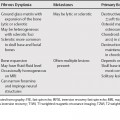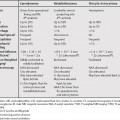149 Both degenerative changes and infection can result in marrow and disk signal changes, as well as enhancement. Differentiation can be difficult at times, as chronic infections can often have indolent presentations. There are findings that can be used to help differentiate infection from degenerative changes (Table 149.1). (For a discussion about neoplastic processes involving the vertebral bodies, please see Chapter 143.) These features can include patterns of enhancement, associated epidural or paraspinal tissue or fluid collections, disk signal changes, and endplate signal changes.
Diskitis/Osteomyelitis, Degenerative Disease, and Scar
| Diskitis / Osteomyelitis | Degenerative | |
|---|---|---|
| Disk Signal | Increased on T2WI Loss of normal hypointense intranuclear cleft | Generally decreased on T2WI (Disks can occasionally develop cystic degeneration that is hyperintense on T2WI.) |
| T1WI Marrow Signal | Decreased | Normal, decreased, increased |
| T2WI Marrow Signal | Increased | Normal, decreased, increased |
| Enhancement | Common in areas of signal abnormality | Occasionally, but less common and less extensive |
| Paraspinal Tissue/ Inflammatory Changes | Generally, yes | Generally, no |
| Epidural Enhancing Tissue/Fluid | Possibly | No |
| Vertebral Body Height | Eventual destruction, collapse on either side of disk space | Can develop some endplate irregularity or Schmorl’s nodes, but not collapse or destruction |
| CT Endplate Changes | Osteolytic foci with endplate fragmentation | May have mild irregularity with sclerosis Generally, no fragmentation |
| Key Differentiating Features |






